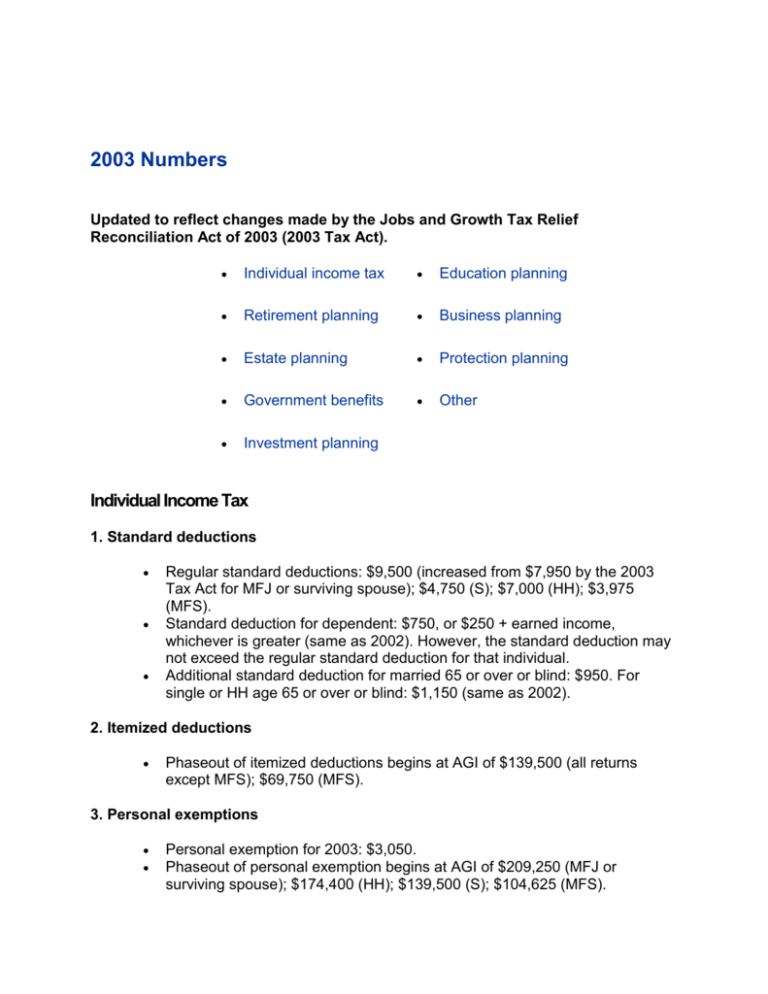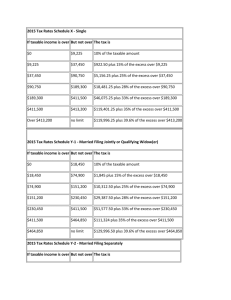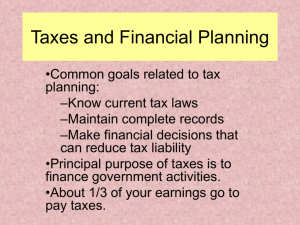2003 Numbers
advertisement

2003 Numbers Updated to reflect changes made by the Jobs and Growth Tax Relief Reconciliation Act of 2003 (2003 Tax Act). Individual income tax Education planning Retirement planning Business planning Estate planning Protection planning Government benefits Other Investment planning Individual Income Tax 1. Standard deductions Regular standard deductions: $9,500 (increased from $7,950 by the 2003 Tax Act for MFJ or surviving spouse); $4,750 (S); $7,000 (HH); $3,975 (MFS). Standard deduction for dependent: $750, or $250 + earned income, whichever is greater (same as 2002). However, the standard deduction may not exceed the regular standard deduction for that individual. Additional standard deduction for married 65 or over or blind: $950. For single or HH age 65 or over or blind: $1,150 (same as 2002). 2. Itemized deductions Phaseout of itemized deductions begins at AGI of $139,500 (all returns except MFS); $69,750 (MFS). 3. Personal exemptions Personal exemption for 2003: $3,050. Phaseout of personal exemption begins at AGI of $209,250 (MFJ or surviving spouse); $174,400 (HH); $139,500 (S); $104,625 (MFS). 4. Kiddie tax Same as 2002 (child under age 14 with unearned income over $1,500 is subject to kiddie tax). AMT exemption for child under age 14: the lesser of (1) $5,600 + child's earned income, or (2) $40,250 (increased from $35,750 by the 2003 Tax Act). 5. Marginal income tax rates The tax rate schedules for 2003 will be as follows: Single taxpayers If taxable income is: Your tax is: Not over $7,000 10% of taxable income Over $7,000 to $28,400 $700 + 15% of the excess over $7,000 Over $28,400 to $68,800 $3,910 + 25% of the excess over $28,400 Over $68,800 to $143,500 $14,010 + 28% of the excess over $68,800 Over $143,500 to $311,950 $34,926 + 33% of the excess over $143,500 Over $311,950 $90,514.50+ 35% of the excess over $311,950 Married filing jointly and surviving spouses If taxable income is: Your tax is: Not over $14,000 10% of taxable income Over $14,000 to $56,800 $1,400 + 15% of the excess over $14,000 Over $56,800 to $114,650 $7,820 + 25% of the excess over $56,800 Over $114,650 to $174,700 $22,282.50 + 28% of the excess over $114,650 Over $174,700 to $311,950 $39,096.50 + 33% of the excess over $174,700 Over $311,950 $84,389 + 35% of the excess over $311,950 Married individuals filing separately If taxable income is: Your tax is: Not over $7,000 10% of taxable income Over $7,000 to $28,400 $700 + 15% of the excess over $7,000 Over $28,400 to $57,325 $3,910 + 25% of the excess over $28,400 Over $57,325 to $87,350 $11,141.25 + 28% of the excess over $57,325 Over $87,350 to $155,975 $19,548.25 + 33% of the excess over $87,350 Over $155,975 $42,194.50 + 35% of the excess over $155,975 Heads of household If taxable income is: Your tax is: Not over $10,000 10% of taxable income Over $10,000 to $38,050 $1,000 + 15% of the excess over $10,000 Over $38,050 to $98,250 $5,207.50 + 25% of the excess over $38,050 Over $98,250 to $159,100 $20,257.50 + 28% of the excess over $98,250 Over $159,100 to $311,950 $37,295.50 + 33% of the excess over $159,100 Over $311,950 $87,736 + 35% of the excess over $311,950 Trusts and estates If taxable income is: Your tax is: Not over $1,900 15% of taxable income Over $1,900 to $4,500 $285 + 25% of the excess over $1,900 Over $4,500 to $6,850 $935 + 28% of the excess over $4,500 Over $6,850 to $9,350 $1,593 + 33% of the excess over $6,850 Over $9,350 $2,418 + 35% of the excess over $9,350 6. Luxury auto excise tax No luxury auto excise tax in 2003. 7. Earned income tax credit (EITC) Disqualified income limit (generally investment income): $2,600. Maximum amount of earned income on which EITC is based: $4,990 (no qualifying children); $7,490 (joint filers with one qualifying child); $10,510 (two or more qualifying children). Phaseout of EITC begins at AGI of $7,240 (joint filers with no qualifying children); $6,240 (for others with no qualifying children); $14,730 (joint filers with one or more qualifying children); $13,730 (for others with one or more qualifying children). 8. Charitable deductions De minimis rules: Charitable contributions will be fully deductible if the donor makes a minimum payment of $40 and receives token gifts with a cost of $8.00 or less. Charitable contributions will also be fully deductible if the benefit received by the donor doesn't exceed the lesser of $80 or 2% of the amount of the contribution. Use of auto for charitable purposes: The deductible standard mileage rate is 14 cents per mile. 9. Foreign earned income exclusion The foreign earned income exclusion is $80,000. 10. Deductible standard mileage rates Use of auto for medical purposes: 12 cents per mile. Use of auto for moving purposes: 12 cents per mile. 11. Child tax credit Increased to $1,000 per qualifying child for 2003 and 2004 (from $600) by the 2003 Tax Act. 12. Alternative Minimum Tax (AMT) Maximum AMT exemption amount for 2003 and 2004 under the 2003 Tax Act: Married filing jointly or surviving spouse, $58,000 (previously $49,000). Single or head of household, $40,250 (previously $35,750). Married filing separately, $29,000 (previously $24,500). AMT income exemption phaseout threshold: Married filing jointly or surviving spouse, $150,000. Single or head of household, $112,500. Married filing separately, $75,000. Investment Planning 1. Capital gains under the 2003 Tax Act 20% rate is reduced to 15% for long-term capital gains on sales or exchanges on or after May 6, 2003 and before January 1, 2009. The 15% rate applies to taxpayers who are in a marginal tax bracket greater than 15%. 10% rate is reduced to 5% (zero in 2008) on long-term capital gains for taxpayers who are in the 15% or lower marginal tax brackets. 2. Dividends under the 2003 Tax Act Dividends received by an individual shareholder from domestic and qualified foreign corporations will generally be taxed at the same rates as capital gains (15%, 5% for those in the 15% or lower marginal tax brackets, with the 5% rate lowered to zero for 2008). This change is effective for dividends received in 2003 through 2008. Previously, dividends were taxed as ordinary income. Education Planning 1. U.S. savings bonds Phaseout of interest exclusion begins at modified AGI over $58,500 ($87,750 on a joint return). 2. Coverdell education savings accounts (formerly known as education IRAs) Annual contribution limit is $2,000. Retirement Planning 1. 401(k), SARSEP, and 403(b) contributions (elective deferrals) Annual contribution limit is $12,000. Elective deferral for a SIMPLE retirement account is $8,000. 2. Section 457 contributions Annual contribution limit is $12,000. 3. Defined contribution plans (Section 415 limit) The dollar limit is $40,000. 4. Defined benefit plans The annual benefit limit is $160,000. 5. IRA contributions (deductible, nondeductible, and Roth IRAs) Annual contribution limit is $3,000 (increasing to $5,000 in 2008), plus $500 catch-up if 50 or older. Business Planning 1. Qualified transportation fringe benefits Employee can exclude up to $190 per month for qualified parking expenses. Employee can exclude up to $100 per month for combined value of transit passes and transportation in a commuter highway vehicle. 2. Earnings subject to Social Security taxes (taxable wage base) Maximum annual earnings subject to Social Security taxes rises to $87,000 in 2003. Social Security and Medicare combined tax rate remains at 15.3% (same as 2002), while the 6.2% OASDI (Old Age, Survivors, and Disability Insurance) tax rate applies to wages up to the new $87,000 wage base. 3. Health insurance deduction for self-employed Deduction for health insurance premiums paid by self-employed is 100% in 2003. 4. Optional standard mileage rate Use of auto for business purposes: 36 cents per mile. 5. Increased section 179 expensing under the 2003 Tax Act Maximum amount that may be deducted under section 179 is increased to $100,000 for property placed in service for tax years 2003, 2004, and 2005 (increased from $25,000). Deduction reduced by amount by which cost of qualifying property placed in service during the year exceeds $400,000 (increased from $200,000). 6. Special additional first-year depreciation allowance for certain property under the 2003 Tax Act Special additional (bonus) first-year depreciation deduction equal to 50% of the adjusted basis of qualified property acquired after May 5, 2003 and before January 1, 2005, and placed in service prior to January 1, 2006. The Job Creation and Worker Assistance Act of 2002 provided for 30% special additional first-year depreciation. Property is not eligible for both the 50% and 30% special additional first-year depreciation. 7. Tax on accumulated earnings and personal holding company income under the 2003 Tax Act The tax rate on accumulated earnings and personal holding company income is reduced to 15% under the 2003 Tax Act. Previously, these items were taxed at the highest marginal personal income tax rate. Estate Planning 1. Gift/transfer tax exclusions The annual gift tax exclusion is $11,000 ($22,000 for spouses). The annual exclusion for gifts to noncitizen spouses is $112,000. The generation-skipping transfer tax (GSTT) exemption is $1,120,000. 2. Special use valuation reduction limit The limit on the decrease in value that can result from the use of special valuation increases to $840,000 in 2003. 3. Qualified conservation easement exclusion If requirements are met, the executor of the estate of a taxpayer dying after 1997 may elect to exclude up to 40% of the value of land subject to a qualified conservation easement. The amount that may be excluded from the gross estate is $500,000 in 2003. Protection Planning 1. Long-term care insurance (LTCI) Qualified LTCI premiums are deductible as medical expenses within the following limits: Age Limit on deduction 40 or less $250 41-50 $470 51-60 $940 61-70 $2,510 71 and over $3,130 Qualified LTCI benefits are excludable from income (as amounts received for personal injuries and sickness), subject to a per diem limitation of $220. Government Benefits 1. Social Security (general information) Amount of earnings required for a quarter of coverage will be $890. Domestic employee coverage threshold will be $1,400. Average monthly Social Security benefit check for retired workers will increase to $895 in January 2003. Maximum monthly benefit for a low-income couple (SSI) will increase to $829. Maximum monthly benefit for a low-income beneficiary (SSI) will increase to $552. Full retirement age increases to 65 years and 2 months. Annual maximum earnings for Social Security beneficiary under full retirement age without a reduction in benefits (retirement earnings test) will be $960 monthly ($11,520 annually). One dollar in benefits will be withheld for every $2 in earnings above the limit. One dollar in benefits will be withheld for every $3 in earnings in excess of the earnings threshold in the calendar year of attaining age 65. The 2003 Social Security monthly PIA (primary insurance amount) formula will be 90% of the first $606 of AIME (average index monthly earnings), plus 32% of the AIME over $606 and through $3,653, plus 15% of the AIME over $3,653. 2. Earnings subject to Social Security taxes (taxable wage base) Maximum annual earnings subject to Social Security taxes rises to $87,000 in 2003. Social Security and Medicare combined tax rate remains at 15.3% (same as 2002), while the 6.2% OASDI (Old Age, Survivors, and Disability Insurance) tax rate applies to wages up to the new $87,000 wage base. 3. Medicare (general information) Medicare Part B premiums rise to $58.70 per month in 2003. Medicare Part B deductible remains at $100 (same as 2002). Medicare Part A monthly premium will be $316 for individuals with less than 30 quarters of Medicare-covered employment and for disabled individuals under age 65 who lost disability benefits because of work and earnings. Medicare Part A monthly premiums for seniors with 30 to 39 quarters of Medicare-covered employment will be $174. 4. Medicare Part A deductibles for inpatient hospital care Deductible for up to 60 days of inpatient hospital care (fee-for-service Medicare) will increase to $840. Deductible for 61 to 90 days will be $210 per day. Deductible for 91 to 150 days will be $420 per day. Deductible for beneficiaries in a skilled nursing facility in a benefit period will be $105 per day for the 21st through 100th day of extended care services. Other 1. Qualified funeral trusts Contributions to a qualified funeral trust may not exceed $7,800.



